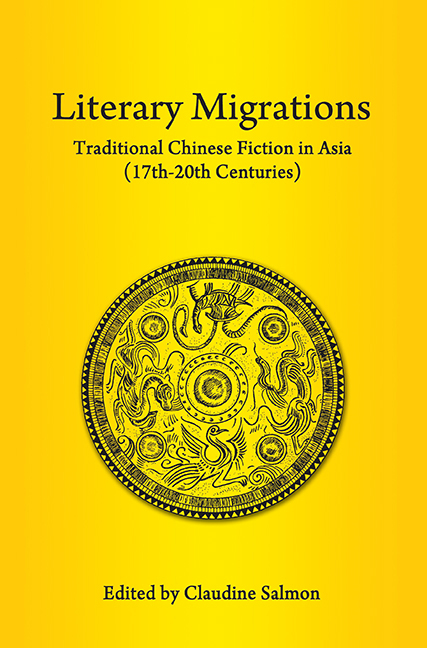Book contents
- Frontmatter
- Contents
- FOREWORD
- Dr Salmon as I Know her
- Preface to Reprint Edition
- Acknowledgements
- INTRODUCTION
- PART I KOREA AND JAPAN
- PART II MAINLAND NORTHEAST ASIA
- 4 The Manchu Translations of Chinese Novels and Short Stories — An Attempt at an Inventory
- 5 A Note about the Spread of Chinese Literature amongst the Mongols
- 6 Mongolian Translations of Old Chinese Novels and Stories — A Tentative Bibliographic Survey
- PART III MAINLAND SOUTHEAST ASIA
- PART IV INSULAR SOUTHEAST ASIA
- Bibliography
- Author, story-teller and translator index
- Title index
- List of Plates
- Contributors
- Plate section
6 - Mongolian Translations of Old Chinese Novels and Stories — A Tentative Bibliographic Survey
from PART II - MAINLAND NORTHEAST ASIA
Published online by Cambridge University Press: 21 October 2015
- Frontmatter
- Contents
- FOREWORD
- Dr Salmon as I Know her
- Preface to Reprint Edition
- Acknowledgements
- INTRODUCTION
- PART I KOREA AND JAPAN
- PART II MAINLAND NORTHEAST ASIA
- 4 The Manchu Translations of Chinese Novels and Short Stories — An Attempt at an Inventory
- 5 A Note about the Spread of Chinese Literature amongst the Mongols
- 6 Mongolian Translations of Old Chinese Novels and Stories — A Tentative Bibliographic Survey
- PART III MAINLAND SOUTHEAST ASIA
- PART IV INSULAR SOUTHEAST ASIA
- Bibliography
- Author, story-teller and translator index
- Title index
- List of Plates
- Contributors
- Plate section
Summary
An American Sinologist, Stephen W. Durrant, in a short note in 1979 raised the question of the importance of studying Manchu and Mongolian translations of old Chinese novels. Indeed, a close study of these translations, the majority of which are preserved in the form of manuscripts, can contribute much that is new not only to the history of Manchu and Mongolian literature or to the study of literary relations in the Far East from the seventeenth to the twentieth century, but also, to a certain extent, to the history of Chinese literature itself. It would be ideal of course to study Manchu and Mongolian translations of Chinese novels simultaneously, since the Mongols often translated from Manchu rather than from Chinese. However, this study would go beyond the capabilities of the author of the present article, who has limited his task to the study of Mongolian translations only.
If, for example, Manchu translations of Chinese novels, undertaken from the mid-seventeenth to the beginning of the nineteenth century remained a fact of translated Manchu literature itself, Chinese novels, having found their way to the Mongols on the one hand with their plots gave life to a special genre of oral Mongolian tales — the bensen üliger, Mongolian song-narrative works based on Chinese novels, and these novels on the other hand became a basis for the creation in the mid-nineteenth century of the first Mongolian novels such as Köke sudur, “The Blue Chronicle”, Nigen dabqur asar, “The One-Story Pavilion”, Ulaghan-a ukilaqu tingkim, “The Scarlet Pavilion of Tears” and Tabun ǰuwan, “Five Tales”. It is known, for example, that in “The Blue Chronicle” by Wangcinbala and his son Inǰannasi, there are episodes inspired by corresponding passages from Luo Guanzhong 's “Romance of the Three Kingdoms”, while “the One-Story Pavilion” by Inǰannasi is a creative reworking of Cao Xuejin 's “Dream of the Red Chamber”.
The first information on the existence of Mongolian translations of Chinese novels was obtained by accident. At the end of the last century, the famous German Sinologist Wilhem Grube purchased in Beijing an old Mongolian manuscript — a translation of the Chinese novel Fan Tang yanyi “Tale of the Revolt against the Tang Dynasty”.
- Type
- Chapter
- Information
- Literary MigrationsTraditional Chinese Fiction in Asia (17th–20th Centuries), pp. 130 - 160Publisher: ISEAS–Yusof Ishak InstitutePrint publication year: 2013



